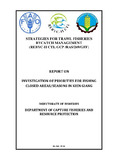| dc.description | Increasing human populations and exploitation pressures, growing threats from pollution and major ecosystem change are particular concerns in Vietnam in general and in KienGiang in particular. Also – as more widely in the global context – the non‐targeted capture of fish and non‐fish species, (fish, turtles, corals and other seabed fauna and flora), commonly called bycatch and discards, is of increasing concern. This part of the catch tends to be poorly monitored and not managed but could have an important impact on fishery resources, habitats and ecosystems. In some fisheries and regions, there is an increasing trend towards the retention of the bycatch consisting of juveniles and small sized fish for use as food for human consumption or for utilization as aquaculture feed. This is therefore a complex issue, requiring resource and biodiversity aspects to be tackled alongside human needs and involving a mix of policy, technical and community support measures. The project “Strategies for trawl fisheries bycatch management” (REBYC‐II CTI) was conceived based on the successes of the 2002‐2008 FAO/UNEP/GEF global project “Reduction of Environmental Impact from Tropical Shrimp Trawling through the Introduction of Bycatch Reduction Technologies and Change of Management”. The REBYC‐II CTI project focuses on multispecies bottom trawling, where bycatch issues are amongst the most serious, with potentially significant effects on ecosystems and livelihoods. The Project is addressing these challenges by promoting sustainable fishing practices and improved trawl management. The REBYC‐II CTI project was developed under the leadership of FAO (the Project implementing agency) in close collaboration with its partners: Southeast Asian Fisheries Development Center (SEAFDEC) and the governments of the participating countries; Indonesia, Papua New Guinea, Philippines, Thailand and Viet Nam. KienGiang province was selected as a pilot site to implement the project in Vietnam. Marine capture fisheries of Vietnam have developed strongly and have significantly contributed to the socio‐economic development, food security and maritime sovereignty of Vietnam. Over the past few years, in KienGiang Province, marine capture fisheries have considerably increased and are contributing significantly to the economic development of the Province. However, these increases have revealed many problems such as unsustainable development, insufficient and uncontrollable fisheries management, uncontrolled number of fishing boats and many fragmented and small‐scale fishing operations. Illegal fishing has been occurring and has seriously been threatening marine resources sustainability, especially in the coastal areas. To overcome the abovementioned shortcomings and to manage the capture fisheries in order to maximize the efficiency of using these resources while also conserving the marine ecosystem, the development and implementation of fishing capacity management mechanisms will be very important. It is also recognized that the fishing capacity management such as fishing restriction, fishing closed season/areas, etc. will be the most relevant so that marine fisheries can continue to make significant contributions to socio‐economic development, food safety and security, coastal community livelihoods, and the generation of foreign exchange through the export of fish and other fisheries products. Temporary closed areas/seasons may be required to protect target stocks from mortality at a specific stage of their life history, such as when a species aggregates to spawn. The value of temporary closed areas/seasons as a management tool has to be assessed on a case‐by‐case basis, and will depend on the biology of the target species and the dynamics of the fishery. It is well recognized that temporary area closures lead to effort displacement if they are not accompanied by catch or effort controls. Management measures based on closed fishing area and season have been implemented in some areas of KienGiang such as PhuQuoc, to reduce fishing capacity and to protect some endangered and threatened species. However, the indicators/criteria used to select such areas need to be reviewed and adjusted, if needed in the changing of fishing activities and related ecosystems. In addition, there have been no investigations to review if the existing closed areas/seasons are being respected and performing well in terms of reducing the effects of trawling activities on fish stocks and demersal ecosystems in Vietnam’s waters. This report will(1) review the existing legislation in relation to fishing closed season/areas including MPA establishment regulations in KienGiang; (2) review the natural characteristics of fishing grounds in KienGiang in order to recommend suitable methods for managing fishing capacity (fishing closed seasons/areas) and (3) recommend suitable criteria to establish fishing closed seasons/areas in KienGiang province. Detailed TOR for this study can be found in the Appendix. | en |

